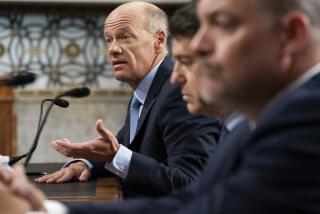SEC Reviews NYSE Broker Supervision
- Share via
NEW YORK — The Securities and Exchange Commission found that the New York Stock Exchange failed to supervise floor brokers under the terms of a 1999 settlement.
The world’s largest stock exchange didn’t conduct “ongoing, continuous surveillance of all floor members,” according to a 10-page SEC report submitted to Congress. The report was obtained by Bloomberg News.
The SEC had rebuked the NYSE for a breakdown in supervision that enabled floor brokers to profit illegally by sharing in customers’ gains. NYSE Chairman Richard Grasso had pledged to initiate a more constant review of members on the floor within a year of the exchange’s June 29, 1999, settlement with the SEC.
“Floor brokers have an awful lot of discretion and you do want some kind of presence to respond to inquiries and detect something as it was occurring rather than wait for an issue to surface months later,” said John Coffee, a Columbia University law professor.
According to an independent consultant hired by the exchange, the NYSE didn’t put regulators on the floor for regular reviews of brokers within 12 months.
NYSE spokesman Ray Pellecchia said the report showed the exchange significantly strengthened its regulatory program.
“The report also identified areas to be improved, which have since been addressed,” Pellecchia said. “The NYSE remains committed to maintaining and enhancing the most vigorous program of market surveillance and self-regulation.”
The 1999 settlement followed the arrests of eight NYSE brokers, who were charged in 1998 with abusing their positions at the exchange, making more than $11 million as a result.
In all, almost two dozen floor brokers were disciplined by the NYSE for splitting profits with customers, a practice forbidden because it gives brokers an unfair advantage because of their knowledge of orders in the market.
SEC inspectors who visited the exchange in September 2000 found “deficiencies” in the NYSE’s surveillance of members, the SEC report said. The following March, attorney Betty Santangelo, hired by the NYSE as a consultant, checked on the exchange’s compliance and confirmed the SEC’s overall findings.
The NYSE’s board received Santangelo’s report April 5, according to the SEC summary.
On April 23, Ed Kwalwasser, the NYSE’s regulation chief, gave Santangelo a memo that said the exchange would put in place most of her recommendations, including improving coordination among departments.
Santangelo, a partner with the law firm Schulte Roth & Zabel, declined to comment. So did SEC Commissioner Laura Unger, who sent the SEC staff summary to Rep. John D. Dingell, a Michigan Democrat.
The NYSE has improved its oversight of floor brokers, the SEC document said. As required, the exchange introduced two mandatory one-hour classes for floor brokers and initiated exams for floor brokers for every other year.
Still, the NYSE’s regulatory group “hadn’t established an on- floor presence to detect and deter violations, as required by the order,” according to Santangelo’s findings.
The SEC could penalize the Big Board, but it’s unlikely, Coffee said. “I don’t think that they would regard anything that has gone on so far as a deliberate violation.”
Unger, in a letter to Dingell accompanying the SEC report, described the NYSE’s compliance with the 1999 SEC settlement as “meaningful” but “an ongoing process.”
Grasso has called the floor broker scandal a low point in his tenure as NYSE chairman and chief executive, which began in 1995. Floor brokers are supposed to buy and sell on behalf of clients. Floor brokers trading for themselves who buy ahead of a big order can pocket a quick profit, knowing the pending buy order may drive a stock price higher.
When the SEC settled its administrative complaint against the NYSE, the SEC’s most pointed criticism was that the exchange didn’t conduct routine surveillance.
Santangelo also noted a lack of coordination for sharing information between units of the NYSE responsible for overseeing floor members: the Division of Member Firm Regulation and the Division of Market Surveillance, according to the SEC report. She found that staff of one division didn’t know about a rule interpretation the other had circulated on the floor.
In addition to increasing its regulatory staff and toughening audit procedures, the NYSE agreed to set up an electronic audit trail--a system for capturing an accurate, time-sequenced record of orders, quotations and transactions on the floor.
The “order trail” system was supposed to be set up in two phases. The first phase, which became effective last month, records the details of an order and the time it entered the system. The second phase, allowing the NYSE to track an order from receipt to settlement, was delayed because of changes the NYSE wants to make to the proposed system that must be reviewed by the SEC.
More to Read
Inside the business of entertainment
The Wide Shot brings you news, analysis and insights on everything from streaming wars to production — and what it all means for the future.
You may occasionally receive promotional content from the Los Angeles Times.










